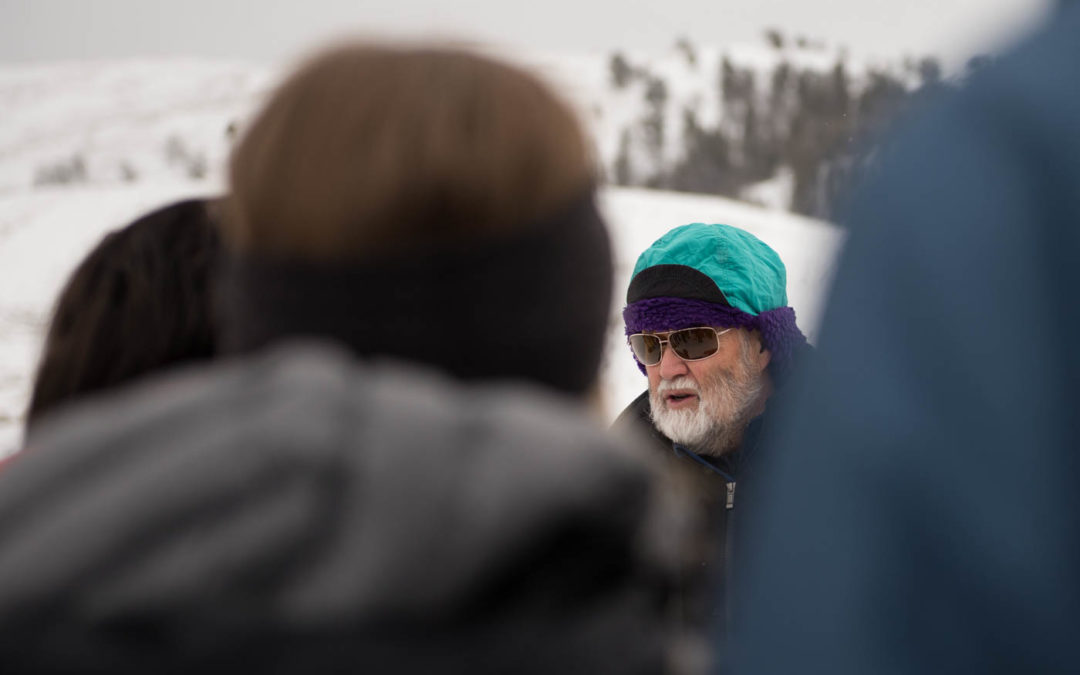Last night four students paired up and spent the night in our custom-made quinzhees. Another brave volunteer, Luke, decided he’d like to try sleeping outside as well, but with just his sleeping pad and sleeping bag. Jim Halfpenny worked with one student, Dylan, to monitor temperatures inside the snow shelter to determine just how many Snickers bars (215 Calories each) he would have had to eat to stay warm through the night. We reconvened after breakfast to hear how the students fared.

Data collection with Dr. Halfpenny. Photo: Melanie Hill
Lindley and Phoebe took one quinzhee, while Dylan and Tel took the other one. Luke was on his own outside in a separate area. Each shelter was stocked up with sleeping pads and sleeping bags, as well as a bag or tarp to cover the entranceway. Jim asked the volunteers how they slept: the girls said they were pretty warm until about 5:00am, and the guys were a bit cold for most of the night. They all agreed that the ground was hard and uncomfortable. Luke said he was fairly warm for the most part, but started to get cold around 3:00am.
Dr. Halfpenny and Dylan reconvened right after breakfast to download data. Dylan was rigged up with two thermometers inside his sleeping bag, and two thermometers outside his bag. Data was being collected every minute throughout the night. With Halfpenny’s calculations, we determined Dylan burned about 1.16 Snickers bars worth of energy last night, which came out to 303 nutritional Calories. Halfpenny’s recommendation for Dylan to stay warm in the future? Carry 2-3 dense foam pads that won’t absorb water. Avoid the Thermarest pads which tend to absorb moisture when you blow them up.

After being properly carved out, quinzhees should be strong enough to hold the weight of 5-6 people on top. Naturally, we had to test it out. Photo: Melanie Hill
After lunch, the class went outside the ranch to dig snowpits and learn about the properties and ecological implications of snow. We dug the first pit together in a flat space, and then split into two groups to dig separate pits in an area with sage brush, and an area with cottonwood trees. Each group dug out snow pits and took measurements of the snowfall in each location. What we learned was the sage brush region tended to be a bit colder, while the cottonwood section was warmest. This demonstrates both the diversity of snowpack as well as diversity of wildlife that reside in these areas that are just a few minutes away from one another.
Before Dr. Halfpenny – a CU Boulder alum – left, he expressed how essential it was for these students to continue on their paths towards environmental conservation. Halfpenny felt these young change-makers were the ones who could truly make a difference in the realm of environmental protections. He closed by reciting a folktale about the “Bear Mother” that left the class in tears, but also instilled a sense of motivation and urgency to protect our wild lands and animals. It was a moment none of us would forget.
It was a long day for the field school participants, and we were thrilled to end with an enthusiastic presentation by George Bumann. Bumann is a professional sculptor and life-long observer of nature who lives in Gardiner, MT. He holds both Bachelor’s and Master’s degrees in wildlife ecology and has worked in the fields of wildlife research, taxidermy, back-country guiding, environmental consulting and has taught art and natural history programs for youth, adult, and university audiences since 1990.
Bumann is especially skilled in his ability to replicate wildlife calls, and began his talk by having us close our eyes and listen to the sounds of Yellowstone- imitated by Bumann himself. Want to hear? Watch this TEDx talk he gave in 2015.





